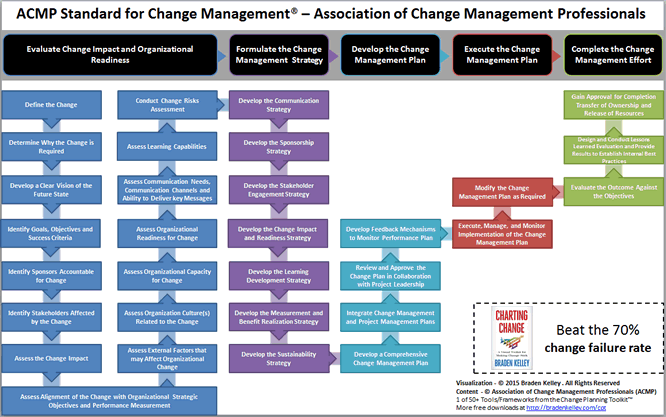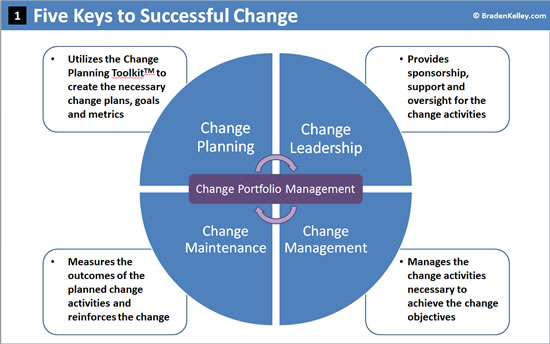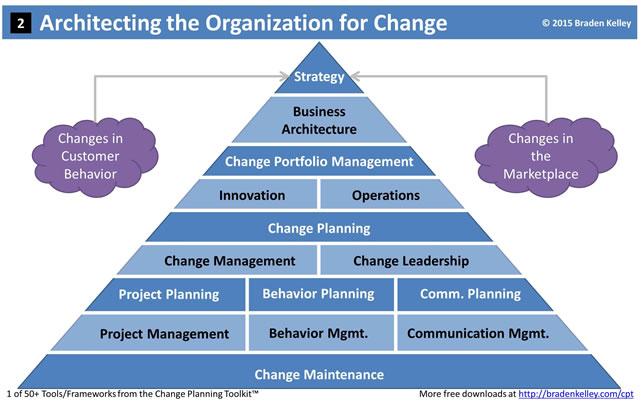Changing Change

The business world is showing an increasing interest in the people side of change, and there is a very real reason for this…
Companies are spending an increasing amount of their budget on technology and working to transform their operations to be more digital in order to provide a better experience for customers, employees, partners and suppliers while simultaneously creating a more efficient and effective business.
Everyone knows that a lot of technology projects fail to achieve their intended objectives, timings, and budgets. This fact and the increasing investment levels are causing more executives to look for ways to de-risk these technology investments in digitizing the business.
That’s why we’re seeing an uptick in the hiring and certification of change management professionals, which is great, but companies are still thinking about the relationship between project management and change management backwards.
In most cases change management is brought to bear as an afterthought, a bolt on to project management when the reverse should be true. Managing a change is a bigger endeavor than managing a project, and in fact you could say that because every project changes something, that every project is a change initiative.
It is thinking about managing projects in this way that I sat down to begin managing a new project several years ago and like many project managers, I found myself sitting at my computer by myself starting at an empty Microsoft Word template for a project charter knowing the uphill battle I’m going to face trying to route this document around via email and succeeding at both getting any responses at all and at getting meaningful input and a diversity of perspectives to make my project charter a really strong document that anyone will actually look at after week two of the project. I also found myself thinking that there has to be a better to plan and execute change initiatives and projects.

And sure people like pull ADKAR (a modified version of AIDA from the marketing world) and the ACMP Standard for Change Management (see the visualization I created above and download it for free here) and John Kotter’s change leadership approach, but they all fall short of making the planning and execution of change initiatives and projects a more visual and collaborative process, so I found myself starting to create new tools to help people (intended to link up with the PMBOK and ACMP Standard for Change Management).
These tools started to collect until they formed a comprehensive and new visual, collaborative approach to planning and executing change initiatives, and yes projects. This collection of tools became known as the Change Planning Toolkit™ and was first introduced in my latest book Charting Change which pairs nicely with my first book Stoking Your Innovation Bonfire. Both are designed to pack more insights into each chapter than most books contain in the entirety of their pages. Two of the most important frameworks introduced in the book are the Five Keys to Successful Change:

And the Architecting the Organization for Change framework:

Both frameworks are designed to help people challenge the way they think about organizational change. They are designed to help people think about more than change management and to think differently about how organizations are transformed and how change management and project management relate to each other.
To help people begin their participation in changing change I’ve made ten free tools available for download from the 50+ tools in the Change Planning Toolkit™, and people who buy a copy of Charting Change get access to 26 of the 50+ tools (including the Visual Project Charter™ and the Change Planning Canvas™). The book does a great job of helping to explain the philosophy behind the toolkit and how to get started with the tools, but people who purchase access to all 50+ tools (including tools to help people think through their Digital Transformation) also get a QuickStart Guide to explain each tool.
But if we are going to truly work together to change how change is planned and executed I thought it would make sense to give people a more in depth sneak preview into what’s inside the toolkit and so I’ve created the following Introduction to the Change Planning Toolkit™ webinar recording:
I encourage you to reflect upon your own experiences planning and executing both projects and change initiatives and what you’ve found lacking in the tools you call upon from ProSci, PMI, ACMP or others and then check out the book and the webinar and then let me know if there are any tools that you feel are still missing – and if it makes sense, I’ll create them!
My goal in creating all of these tools for you after all is to help you beat the 70% change failure rate, so let’s work together at changing change so our organizations are capable with more capably transforming themselves as the environment changes around them.
You can let me know if there are any change tools that you still need (or if you’d like me to come show you and your team personally how to use them) via the contact form here on Innovation Excellence or by clicking on the banner below and clicking on the contact link on my personal site.
Let’s change change together!
Wait! Before you go…
Choose how you want the latest innovation content delivered to you:
- Daily — RSS Feed — Email — Twitter — Facebook — Linkedin Today
- Weekly — Email Newsletter — Free Magazine — Linkedin Group
[author image=”https://www.disruptorleague.com/wp-content/uploads/2016/07/Braden-Kelley-70.jpg”]Braden Kelley is a popular innovation speaker, builds sustainable innovation cultures, and tools for creating successful change. He is the author of the five-star book Stoking Your Innovation Bonfire and the creator of a revolutionary new Change Planning Toolkit™. Follow him on Twitter (@innovate) and Linkedin.[/author]
NEVER MISS ANOTHER NEWSLETTER!
LATEST BLOGS
How Brexit Has Affected UK E-commerce Businesses
Photo by Zyro on Unsplash The popularity of online shopping was already growing at an impressive rate – and…
Read MoreOvercoming range anxiety: three tips for EV owners
Photo by Jenny Ueberberg on Unsplash In the last few years, electric vehicles (EVs) have become more and more…
Read More


